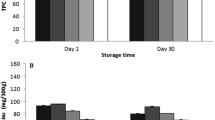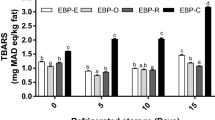Abstract
Though fresh-cut products save our time, but they are very much prone to enzymatic browning that drastically affects product’s quality and marketability. Drumstick pods are considered as super food due to high nutritional contents. However, the fresh-cut pods are prone to brown discoloration. The enzyme activities promote the softening and cut-surface browning of pods, thus deteriorates their texture, decreases consumer appeal and shortens the shelf life. So, we aimed to assess the effect of citric (1%) and ascorbic (1%) acid treatments on quality attributes of fresh-cut drumsticks at 3-d interval during storage (5 ± 1 °C). In general there was an increase in lignin and quinone contents, while phenolic content was decreased during storage. However, samples subjected to ascorbic acid dip had higher phenolic content, lower rate of lignin formation, and reduced membrane permeability. Enzyme activities (polyphenol oxidase and peroxidase) were found to increase during storage, however, samples treated with ascorbic acid showed lower activities than that of the control and citric acid treated samples. The reduced enzyme activities resulted in the reduced browning incidence and maintained the quality. Therefore, postharvest dip of fresh-cut drumstick in to ascorbic acid (1%) could be suggested to increase the shelf life with reduced browning during low temperature storage.






Similar content being viewed by others
References
Ahvenaien R (1996) New approaches in improving the shelf life of minimally processed fruits and vegetables. Trends Food Sci Technol 7(6):179–187
Altisent R, Plaza L, Alegre I, Viñas I, Abadias M (2014) Comparative study of improved vs. traditional apple cultivars and their aptitude to be minimally processed as ‘ready to eat’ apple wedges. LWT-Food Sci Technol 58:541–549
Altunkaya A, Gokmen V (2008) Effect of various inhibitors on enzymatic browning, antioxidant activity and total phenol content of fresh lettuce (Lactuca sativa). Food Chem 107(3):1173–1179
An J, Zhang M, Lu Q (2007) Changes in some quality indexes in fresh-cut green asparagus pretreated with aqueous ozone and subsequent modified atmosphere packaging. J Food Eng 78:340–344
Anwar F, Bhanger MI (2003) Analytical characterization of Moringa oleifera seed oil grown in temperate regions of Pakistan. J Agric Food Chem 51:6558–6563
Anwar F, Ashraf M, Bhanger MI (2005) Interprovenance variation in the composition of Moringa oleifera oilseeds from Pakistan. J Am Oil Chem Soc 82:45–51
Aquino-Bolanos EN, Mercado-Silva E (2004) Effects of polyphenol oxidase and peroxidase activity, phenolics and lignin content on the browning of cut jicama. Postharvest Biol Technol 33(3):275–283
Azevedo VM, Dias MV, de Siqueira Elias HH, Fukushima KL, Silva EK, Carneiro JDDS, Borges SV (2018) Effect of whey protein isolate films incorporated with montmorillonite and citric acid on the preservation of fresh-cut apples. Food Res Int 107:306–313
Cantos E, Tudela JA, Gil MI, Espin JC (2002) Phenolic compounds and related enzymes are not rate-limiting in browning development of fresh-cut potatoes. J Agric Food Chem 50:3015–3023
Chen HZ, Zhang M, Bhandari B, Guo Z (2018) Evaluation of the freshness of fresh-cut green bell pepper (Capsicum annuum var. grossum) using electronic nose. LWT-Food Sci Technol 87:77–84
Chung H-S, Moon KD (2009) Browning characteristics of fresh-cut ‘Tsugaru’ apples as affected by pre-slicing storage atmospheres. Food Chem 114:1433–1437
Degl’Innocenti E, Pardossi A, Tognoni F, Guidi L (2007) Physiological basis of sensitivity to enzymatic browning in ‘lettuce’,‘escarole’and ‘rocket salad’when stored as fresh-cut products. Food Chem 104:209–215
Deng Y, Wu Y, Li YF (2005) Effects of high O2 levels on post-harvest quality and shelf life of table grapes during long-term storage. Eur Food Res Technol 221:392–397
Ghasi S, Nwobodo E, Ofili JO (2000) Hypocholesterolemic effects of crude extract of leaf of Moringa oleifera Lam in high-fat diet fed Wistar rats. J Ethnopharmacol 69:21–25
Gorny JR, Hess-Pierce B, Cifuentes RA, Kader AA (2002) Quality changes in fresh-cut pear slices as affected by controlled atmospheres and chemical preservatives. Postharvest Biol Technol 24:271–278
He Q, Luo Y (2007) Enzymatic browning and its control in fresh-cut produce. Stewart Postharvest Review 3(6):1–7
Jang JH, Moon KD (2011) Inhibition of polyphenol oxidase and peroxidase activities on fresh-cut apple by simultaneous treatment of ultrasound and ascorbic acid. Food Chem 124:444–449
Kuwar U, Sharma S, Tadapaneni VRR (2015) A loe vera gel and honey-based edible coatings combined with chemical dip as a safe means for quality maintenance and shelf life extension of fresh-cut papaya. J Food Qual 38(5):347–358
Lamikanra O, Watson MA (2001) Effects of ascorbic acid on peroxidase and polyphenoloxidase activities in fresh-cut cantaloupe melon. J Food Sci 66(9):1283–1286
Li-Qin Z, Jie Z, Shu-Hua Z, Lai-Hui G (2009) Inhibition of browning on the surface of peach slices by short-term exposure to nitric oxide and ascorbic acid. Food Chem 114(1):174–179
Luo Z, Wang Y, Jiang L, Xu X (2015) Effect of nano-CaCO3-LDPE packaging on quality and browning of fresh-cut yam. LWT-Food Sci Technol 60:1155–1161
Lurie S, Fallik E, Handros A, Shapira R (1997) The possible involvement of peroxidase in resistance to Botrytis cinerea in heat treated tomato fruit. Physiol Mol Plant Pathol 50:141–149
Meng X, Zhang M, Adhikari B (2012) Extending shelf-life of fresh-cut green peppers using pressurized argon treatment. Postharvest Biol Technol 71:13–20
Oms-Oliu G, Rojas-Graü MA, González LA, Varela P, Soliva-Fortuny R, Hernando MIH, Martín-Belloso O (2010) Recent approaches using chemical treatments to preserve quality of fresh-cut fruit: a review. Postharvest Biol Technol 57:139–148
Qadri OS, Yousuf B, Srivastava AK (2015) Fresh-cut fruits and vegetables: critical factors influencing microbiology and novel approaches to prevent microbial risks—a review. Cogent Food Agric 1(1):1121606
Raymond LV, Zhang M, Karangwa E, Chesereka MJ (2013) Mixed noble gas effect on cut green peppers. Int Agrophys 27(1):75–79
Rico D, Martin-Diana AB, Barat JM, Barry-Ryan C (2007) Extending and measuring the quality of fresh-cut fruit and vegetables: a review. Trends Food Sci Technol 18:373–386
Sothornvit R, Kiatchanapaibul P (2009) Quality and shelf-life of washed fresh-cut asparagus in modified atmosphere packaging. LWT-Food Sci Technol 42(9):1484–1490
Ventura-Aguilar RI, Colinas-León MT, Bautista-Baños S (2017) Combination of sodium erythorbate and citric acid with MAP, extended storage life of sliced oyster mushrooms. LWT-Food Sci Technol 79:437–444
Vina SZ, Chaves AR (2003) Texture changes in fresh cut celery during refrigerated storage. J Sci Food Agric 83(13):1308–1314
Yousuf B, Qadri OS, Srivastava AK (2018) Recent developments in shelf-life extension of fresh-cut fruits and vegetables by application of different edible coatings: a review. LWT-Food Sci Technol 89:198–209
Author information
Authors and Affiliations
Corresponding author
Additional information
Publisher's Note
Springer Nature remains neutral with regard to jurisdictional claims in published maps and institutional affiliations.
Rights and permissions
About this article
Cite this article
Siddiqui, M.W., Homa, F., Nayyer, M.A. et al. Browning metabolism and quality of fresh-cut drumstick (Moringa oleifera) as influenced by acidulant treatments. J Food Sci Technol 57, 2010–2016 (2020). https://doi.org/10.1007/s13197-019-04233-3
Revised:
Accepted:
Published:
Issue Date:
DOI: https://doi.org/10.1007/s13197-019-04233-3




